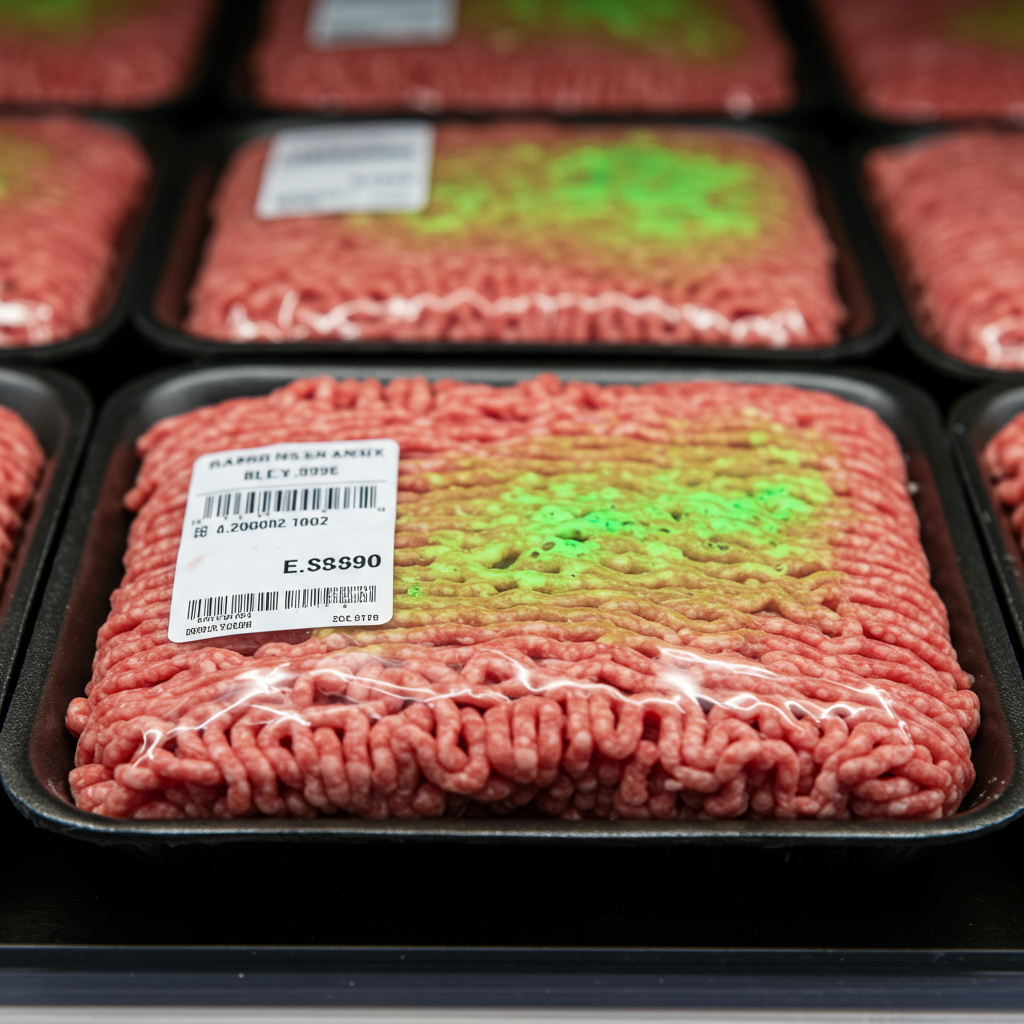For years, urinary tract infections (UTIs) were largely blamed on personal hygiene. But groundbreaking new research is shifting this perspective dramatically. A significant portion of these uncomfortable, and sometimes dangerous, infections may actually stem from E. coli bacteria found in contaminated meat purchased right from your local grocery store. This revelation redefines UTIs not just as a personal health matter, but a critical food safety concern impacting millions.
The Unseen Link: Contaminated Meat and UTIs
UTIs are incredibly common, affecting approximately 400 million people globally each year. They occur when bacteria enter the urethra and infect the urinary tract. While E. coli is a well-known cause of UTIs, public health agencies often discuss it in the context of strains causing diarrhea. This focus meant the link between E. coli from food and UTIs was largely overlooked for decades. New studies, however, are bringing this crucial connection to light, challenging long-held assumptions about how these infections develop. It’s time to understand the hidden risks lurking in our food supply.
Groundbreaking Research Uncovers the Source
A multi-year study, published in prestigious journals like mBio and the American Society for Microbiology, offers compelling evidence. Between 2017 and 2021, researchers from George Washington University and Kaiser Permanente Southern California embarked on an ambitious project. They collected over 5,700 urine samples positive for E. coli from UTI patients across Southern California. Concurrently, they gathered samples of various meats – including chicken, turkey, pork, and beef – from grocery stores in the very neighborhoods where these patients lived.
Using sophisticated “genomic attribution” techniques and whole-genome sequencing, the team meticulously compared the DNA signatures of E. coli strains. Their findings were stark. Approximately one in five (18-20%) of the E. coli-related UTIs analyzed could be directly linked to exposure from contaminated meat. Lance Price, the senior author and a professor at George Washington University, articulated this pivotal shift: “Urinary tract infections have long been considered a personal health issue, but our findings suggest that they are also a food safety problem.”
Understanding the Culprit: ExPEC E.coli
It’s important to distinguish the specific E. coli strains involved in these foodborne UTIs. Unlike the notorious strains that cause severe gastrointestinal issues like diarrhea and vomiting, these are primarily extraintestinal pathogenic E. coli (ExPEC). ExPEC strains can reside harmlessly in the human gut, often acquired through consuming or handling contaminated food. The danger arises if these bacteria migrate from the gut to the urethra and subsequently ascend into the urinary tract, leading to a painful infection.
The study detailed varying levels of E. coli contamination in raw meat samples. Chicken and turkey showed the highest rates, with E. coli found in 38% and 36% of samples respectively. Beef followed at 14%, and pork at 12%. This data suggests a clear hierarchy of risk among common meat types, making poultry a particular area of concern for consumers and the meat industry alike.
Disproportionate Impact on Vulnerable Communities
The research also highlighted significant socioeconomic disparities. Individuals residing in lower-income areas faced a 60% higher risk of contracting foodborne UTIs compared to those in wealthier neighborhoods. In fact, nearly 21.5% of E. coli isolates from patients in high-poverty areas were zoonotic, originating from animals.
While the exact reasons for this strong correlation are still being explored, several factors are hypothesized. Researchers observed higher contamination rates in large, low-cost “value packs” of meat often found in these communities. Furthermore, issues like inadequate storage temperatures, poorer retail conditions, and a general lower quality of products in disadvantaged neighborhoods might contribute. Concerns were raised about chicken packages “bloated with saline,” suggesting potential leakage of bacteria-laden liquid onto grocery items. This disparity underscores the urgent need to address food safety as a social justice issue, demanding greater investment in research on the social determinants of health.
How E. coli Makes the Journey from Meat to UTI
The pathway from contaminated meat to a human UTI typically involves two main stages. First, E. coli from raw meat enters the human gastrointestinal tract. This can happen through direct contact when handling raw meat during preparation, or indirectly by consuming undercooked meat. Once in the gut, these ExPEC strains can become part of a person’s normal gut flora.
The second stage involves the transfer of these bacteria from the gut to the urethra. This is often facilitated by improper hygiene, such as inadequate handwashing after handling raw meat or improper wiping after using the toilet. Women are particularly susceptible due to their anatomy—a shorter urethra and its close proximity to the anus make it easier for bacteria to travel to the bladder. Once bacteria enter the urethra, they can ascend, causing an infection in the urinary tract. Cross-contamination in the kitchen, where raw meat juices can spread to other foods or surfaces, is a primary mode of transmission.
A Call for Industry and Consumer Action
This extensive research provides a clear roadmap for mitigating the risk of foodborne UTIs. While consumers bear some responsibility, experts like Lance Price argue that the food supply chain and regulatory bodies must implement stricter measures. Recommendations for the industry include: stronger slaughterhouse hygiene, stricter contamination standards for meat, improved inspection protocols, and advocating for universal leak-proof packaging to prevent bacterial spread in grocery stores. Some experts even suggest vaccinating livestock against common UTI-causing E. coli strains.
Consumers also play a vital role in protecting themselves and their families. By adopting rigorous food safety practices, individuals can significantly reduce their exposure risk. These simple yet effective steps are crucial for maintaining urinary tract health and preventing the spread of these resilient bacteria.
Essential Food Safety Practices for Consumers:
Mindful Shopping: Always choose meat and poultry products that are securely sealed. Avoid packages that appear damaged, leaky, or “bloated” with excess liquid, as this could indicate higher contamination risk.
Thorough Cooking: Cook all meat and poultry to their recommended internal temperatures. This effectively kills harmful bacteria like E. coli. Consult the CDC website or a reliable food thermometer for precise temperature guidelines.
Prevent Cross-Contamination: This is perhaps the most critical step. Use separate cutting boards for raw meat and other foods like produce or ready-to-eat items. Avoid using the same utensils for raw and cooked foods without washing them thoroughly in between.
Impeccable Hand Hygiene: Wash your hands with soap and warm water for at least 20 seconds after handling raw meat, poultry, or seafood, and before touching any other food items or kitchen surfaces.
Sanitize Surfaces: Meticulously clean and sanitize all kitchen surfaces, countertops, and utensils that have come into contact with raw meat juices. Use hot soapy water or a sanitizing solution.
Proper Storage: Store raw meats and poultry on the lowest shelves in your refrigerator. This prevents any potential drips or leaks from contaminating other foods stored below them.
Beyond food handling, general UTI prevention strategies remain important. These include staying well-hydrated, urinating after sexual activity, wiping from front to back, and avoiding irritating feminine hygiene products. For individuals experiencing recurrent UTIs, seeking medical advice for a personalized diagnosis and treatment plan is essential.
Frequently Asked Questions
What specific E. coli strains from meat cause UTIs, and how do they differ from diarrhea-causing E. coli?
The E. coli strains primarily responsible for foodborne UTIs are known as extraintestinal pathogenic E. coli (ExPEC). Unlike the more commonly recognized E. coli strains that trigger symptoms like severe diarrhea and vomiting, ExPEC typically do not cause gastrointestinal illness. This distinction is crucial because it explains why the link between contaminated meat and UTIs was overlooked for so long. ExPEC can reside asymptomatically in the human gut after being consumed or transferred from raw meat, but they possess specific genetic traits that allow them to cause infections when they migrate to other parts of the body, such as the urinary tract.
Where are foodborne UTIs most prevalent, and what demographic factors increase risk?
Foodborne UTIs linked to contaminated meat are particularly prevalent in Southern California, where the groundbreaking study was conducted, suggesting the issue is widespread across the U.S. Demographically, women are generally more susceptible to UTIs due to their anatomy. However, the study also revealed a significant socioeconomic disparity: individuals living in lower-income areas face a 60% higher risk of contracting foodborne UTIs. This is potentially due to factors like higher contamination rates in “value packs” of meat, poorer retail conditions in certain neighborhoods, and issues with food storage and handling.
What are the most effective steps consumers can take to prevent foodborne UTIs from contaminated meat?
Consumers can significantly reduce their risk of foodborne UTIs by strictly adhering to several food safety practices. Key recommendations include purchasing securely sealed meat to prevent leakage and thoroughly cooking all meat and poultry to the recommended internal temperatures to kill bacteria. Preventing cross-contamination is paramount: use separate cutting boards and utensils for raw meat, and meticulously wash hands and all kitchen surfaces after handling raw meat. Proper refrigerator storage, with raw meat on the lowest shelves, also helps prevent bacterial spread. These actions collectively empower consumers to protect their urinary tract health.
This new understanding fundamentally changes how we view UTIs. While personal hygiene remains important, the spotlight is now firmly on food safety as a crucial component of urinary tract health. By demanding stricter industry standards and implementing diligent practices in our own kitchens, we can collectively work towards reducing the burden of these common and often painful infections. Staying informed and proactive about the food we consume is now more vital than ever.




